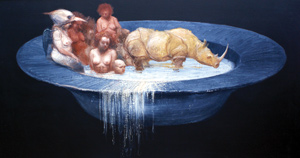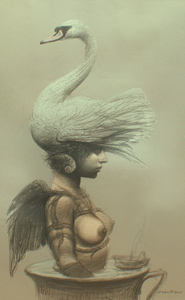The characters created by Roberto Fabelo (Camagüey,1950) dwell ina supra-real, oneiric world, in a place in which fantasy and the power of imagination get fired up to paroxistic levels; a parallel world with a set of rules of its own, its own codes of behavior and ethics full of beings that move past our rational comprehension and seduce us in an overwhelming and unshackled way. Mermaids, fauns, birdmen, centaurs and many other figures that depict the author’s obsession with that blend between human and animal forms, parade before our very eyes sowing the seeds of doubt, mystery and empathy. And we also make out dwarfs, fats and other female naked bodies that usually combine esthetic pleasure and displeasure, eroticism and its opposite, sensuality and the most scathing and bizarre things. They are indecent bodies that pique spectators and egg on sexual arousal, yet they also unleash rejection and repulsion for their decomposed and hypertrophied deformity. These women come in a Pandora’s Box that curious and naïve spectators pry wide open.
 Another visible symbol is the mask. The characters of the author’s canvases are jam-packed with masks, mostly covering their faces and overlapping one another as they make up several layers of fragmented and diverse human flesh. It seems as if they were hiding their true personality, their inner selves. They live in folded patterns, in simulation and pretention. They have turned camouflage into their basic MO, perhaps because the context demands it that way. In this same breath, one of the author’s best-known watercolor series –Pequeño teatro (1992-1995)– is particularly revealing. In this series, the characters’ poses and looks, coupled with the selection and layout of the objects within the eyeshot, mimic an esthetic stemming from the performing arts in terms of staging codes. The fact of the matter is that Fabelo’s creations see the world as one big theater in which the most unsuspected characters can put on a show –or maybe we are the ones simulating that other apocryphal, chimerical existence.
Another visible symbol is the mask. The characters of the author’s canvases are jam-packed with masks, mostly covering their faces and overlapping one another as they make up several layers of fragmented and diverse human flesh. It seems as if they were hiding their true personality, their inner selves. They live in folded patterns, in simulation and pretention. They have turned camouflage into their basic MO, perhaps because the context demands it that way. In this same breath, one of the author’s best-known watercolor series –Pequeño teatro (1992-1995)– is particularly revealing. In this series, the characters’ poses and looks, coupled with the selection and layout of the objects within the eyeshot, mimic an esthetic stemming from the performing arts in terms of staging codes. The fact of the matter is that Fabelo’s creations see the world as one big theater in which the most unsuspected characters can put on a show –or maybe we are the ones simulating that other apocryphal, chimerical existence.
But his works are also dominated by violence. Suffering, horror and savagery. We are dealing with figures that cry out in pain and suffer from a number of reasons. Let’s think, for instance, in the emblematic series of drawings on Kraft paper entitled Vital Fragments that dates back to the 1980s and in which the characters are maimed, tied up, beat up, locked up in huge jars –they stand for hardships and hunger– or just lying dead in their beds. In the meantime, their eyes are dislocated, lost, dehumanized and full of extreme existential misery. These impressions are highlighted through the use of hardened lines that for a moment seem to leave the figures unfinished, yet they convey harshness and textural richness thanks to the use of Kraft paper and the way it has been ripped off by the artist, thus deriving in rugged, uneven shapes that are eventually laid out on the paper and hanged on the wall, in the raw, featuring no other mounting device whatsoever. That’s precisely just another characteristic that singles Fabelo out: his liking for unconventional materials, including cardboard, wood, printed cloths, stained pots. Let’s remember the World exhibit back in 2005.
 In addition to being an excellent drawer and painter –both in watercolors and oil– Fabelo has rigorously tried his hand at the 3D domains, especially in the form of installations. In this direction, let’s recall The Table (Un poco de mí, 2003), “Worlds” (2005) and “Survivors” (2008-09), the latter unveiled within the framework of the Tenth Havana Biennial. In the first, all the attention was focused on food problems hitting contemporary human beings, while the second one meant to be a denunciation to man’s devastating action on his own environment and in which the planet was portrayed as a doomed place in which all species were walking along the pit’s brink into total extinction. In “Survivors” the readings could be far more piercing and hurting. Beyond the possible allusions to cockroaches as the only potential survivors of a nuclear catastrophe and the Kafkaesque reference to the metamorphosis suggested in the human-insect hybrids, a few questions that make interpretations on the work both richer and more complex pop up. What were these cockroaches doing in such a sublime place as the National Museum of Fine Arts? Why did they wind up there in the first place if they actually live in smudge and dirtiness? Was this a discourse on the museum as an institution? Was it on the kind of art treasured in there? The contrast between the nature of the exposed animal and the location chosen for that exhibit becomes a product with a highly suggestive sense. “Our museum is infested with roaches,” some could think, and that’s quite a strong sentence. I don’t know whether that was one of the author’s discursive intentions. I don’t even want to know that. That’s one of art’s virtues, its polysemy; the multiplicity of possible readings. Humberto Eco referred to that in his theory on “open works” when he wrote: “the work is not complete until after it’s been received, so that explains there are as many works as spectators.” Any act of interpretation implies an act of execution and co-creation. Fabelo has his cockroaches and I’ve got mine…
In addition to being an excellent drawer and painter –both in watercolors and oil– Fabelo has rigorously tried his hand at the 3D domains, especially in the form of installations. In this direction, let’s recall The Table (Un poco de mí, 2003), “Worlds” (2005) and “Survivors” (2008-09), the latter unveiled within the framework of the Tenth Havana Biennial. In the first, all the attention was focused on food problems hitting contemporary human beings, while the second one meant to be a denunciation to man’s devastating action on his own environment and in which the planet was portrayed as a doomed place in which all species were walking along the pit’s brink into total extinction. In “Survivors” the readings could be far more piercing and hurting. Beyond the possible allusions to cockroaches as the only potential survivors of a nuclear catastrophe and the Kafkaesque reference to the metamorphosis suggested in the human-insect hybrids, a few questions that make interpretations on the work both richer and more complex pop up. What were these cockroaches doing in such a sublime place as the National Museum of Fine Arts? Why did they wind up there in the first place if they actually live in smudge and dirtiness? Was this a discourse on the museum as an institution? Was it on the kind of art treasured in there? The contrast between the nature of the exposed animal and the location chosen for that exhibit becomes a product with a highly suggestive sense. “Our museum is infested with roaches,” some could think, and that’s quite a strong sentence. I don’t know whether that was one of the author’s discursive intentions. I don’t even want to know that. That’s one of art’s virtues, its polysemy; the multiplicity of possible readings. Humberto Eco referred to that in his theory on “open works” when he wrote: “the work is not complete until after it’s been received, so that explains there are as many works as spectators.” Any act of interpretation implies an act of execution and co-creation. Fabelo has his cockroaches and I’ve got mine…
We’re running across, then, a versatile, prolific and ever-invigorating creator who’s a total stranger to any nuance or catchy trend, a man who’s self-assured of both his aura and his creed. He’s no doubt one of Cuba’s greatest fine arts masters of all time who knows how to dole out his art in timely doses and moment, but never in excess. Perhaps that’s why he’s so beloved and respected. He’s a dignified recipient of the highest recognition granted by the National Council of Fine Arts of the Republic of Cuba, a distinction he deservedly won in 2004.
Havana, May 2010
Related Publications

How Harumi Yamaguchi invented the modern woman in Japan
March 16, 2022












